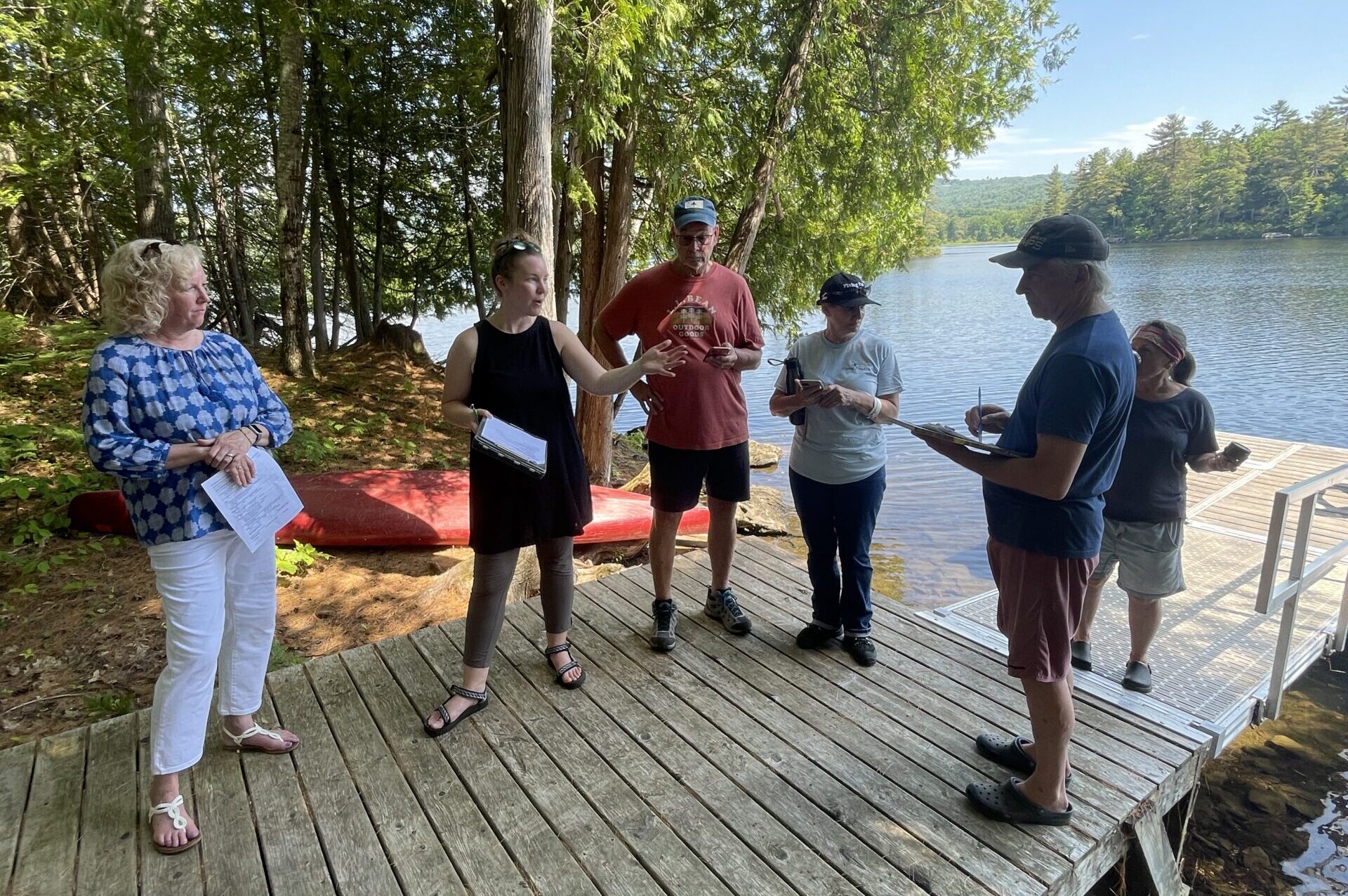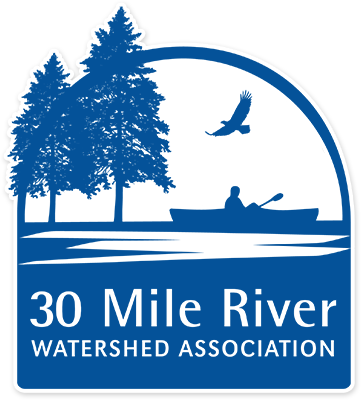David Pond Water Quality Report | 2024
2024 Water Quality Monitoring Season Snapshot
30 Mile staff and volunteers monitor water quality on lakes and ponds in the watershed. Between May and October, we monitor nine lakes on a bi-weekly schedule, two small ponds three times a season, and two additional small ponds once per season.
On David Pond:
Water Quality Monitoring trips
Secchi readings
EC’s & BG’s collected
DO & Temp profiles collected

Secchi Disk Transparency (Water Clarity)
Secchi disk transparency (SDT) is an indicator of water clarity. To measure water clarity, a black and white disk is lowered into the water and the reading is taken at the depth at which it is no longer visible. Factors that affect water clarity include algal growth, zooplankton densities, natural water color, and suspended silt or sediment particles.
2024 average: 6.1 meters (20 feet)
2024 min: 5.55 meters (18 feet)
2024 max: 7.1 meters (23 feet)
Maine Lakes Secchi Average: 4.8 meters (16 feet)
David Pond historical Secchi average: 5.8 meters (19 feet)

Temperature and Dissolved Oxygen (DO)
Temperature readings:
Dissolved Oxygen readings:
Total Phosphorus
Phosphorus is the key nutrient driving algae growth in lakes. Because it occurs naturally in very small amounts, phosphorus “limits” the growth of algae in lake ecosystems. Even slight increases in phosphorus can lead to significant increases in algal growth, which hinders not only the overall health of the lake system but also the economic, recreational, and aesthetic values. Tracking phosphorus levels over time helps monitor changes in water quality.
6 ppb
2024
EC minimum
7 ppb
2024
EC average
7 ppb
2024
EC maximum
7.4 ppb
Historical EC average
on David Pond
12 ppb
Average EC on
Maine Lakes
Epilimnetic core's (EC's) are collected from the top layer of the lake/pond using an integrated core sampler. Generally, in-lake EC Total Phosphorus (TP) concentrations should stay below 10 ppb. Lakes with phosphorus concentrations of ~13 ppb or more are known to sustain algal blooms, and blooms become frequent as average concentrations approach 20 ppb.
13 ppb
2024
BG minimum
18 ppb
2024
BG average
22 ppb
2024
BG maximum
17.7 ppb
Historical BG average
on David Pond
Total Phosphorus (TP) samples were collected from the bottom of the lake or pond using a Kemmerer grab sampler; this type of sample is known as a “bottom grab”. Bottom grabs (BG) are collected when anoxia is encountered anywhere in the dissolved oxygen profile, and help us determine if there is active phosphorus release from bottom sediments exposed to anoxic conditions.
Chlorophyll-a (Chl-a)
Chlorophyll is found in plants (including algae) and is used to convert sunlight into energy. Measuring the concentration of Chlorophyll in lake water helps us estimate the algae population in the lake.
2.2 ppb
2024
Chl-a minimum
3.6 ppb
2024
Chl-a average
5.5 ppb
2024
Chl-a maximum
3.4 ppb
Historical Chl-a average
on David Pond
6.4 ppb
Average Chl-a on
Maine Lakes
Advanced Chemistry Parameters
Once per season in August, 30 Mile collects water samples and analyzes them for advanced chemistry parameters.
pH
pH helps determine which plant and animal species can live in the lake, and it governs biochemical processes that take place. The pH scale ranges from 0- 14, with 7 being neutral. Water is increasingly acidic below 7, and increasingly alkaline above 7.
2024 pH: 6.8
Maine Lakes pH average: 6.4
David Pond historical pH average: 6.9
True Color
Water color refers to the concentration of natural dissolved organic acids. This includes natural tannins and lignins dissolved in the water, often resulting in "tea" or "root beer" colored water in very colored lakes. “True Color” is measured in Platinum Cobalt Units (PCU) after all particulates (including algae cells) have been filtered out of the sample. Colored lakes (>25 PCU) can naturally have reduced transparency readings and increased phosphorus values. However, this does not mean the lakes produce more algae. The color simply reduces the transparency such that the reading is not a good measure of algal biomass. Chlorophyll-a (Chl-a) is the best indicator of algal productivity in colored lakes and should be used if possible.
2024 color: 12 PCU
Maine Lakes Color average: 20.7 PCU
David Pond historical Color average: 18.76 PCU
Conductivity
Conductivity measures the ability of water to carry electrical current and is directly related to the dissolved ions (charged particles) present in the water. Fishery biologists can use conductivity values to calculate fish yield estimates because conductivity will generally increase if there is an increase of pollutants entering the lake or pond. Stormwater runoff from developed areas and roadways is the most common pollutant in Maine lakes that can raise conductivity values. Conductivity is measured in micromhos per centimeter (µMHOS/cm).
2024 conductivity: 57 µMHOS/cm
Maine Lakes Conductivity average: 51.1 µMHOS/cm
David Pond historical Conductivity average: 46.98 µMHOS/cm
Alkalinity
Alkalinity is also referred to as “buffering capacity.” It is a measure primarily of naturally available bicarbonate, carbonate, and hydroxide ions in the water and is measured in milligrams per liter (mg/L). Measuring alkalinity is important to determining a lake’s ability to neutralize acidic pollution from rainfall or snowmelt. Lakes with alkalinity values >20 mg/L are considered well buffered against pH changes over time. Lakes with low or zero alkalinity may have more variation in pH levels that can sometimes result in damage to aquatic life.
2024 alkalinity: 10 mg/L
Maine Lakes Alkalinity average: 11.7 mg/L
David Pond historical Alkalinity average: 9.25 mg/L
What can I do to help protect David Pond?

Sign up to Volunteer
Monitoring is conducted May-September. Volunteers work alongside our staff, in a canoe or motor boat, assisting in data collection.

Request a LakeSmart Visit
LakeSmart helps lakefront homeowners manage landscapes in ways that protect water quality. It is free, non-regulatory, and voluntary.

Support 30 Mile
It takes a community to protect our precious lakes. Support our work for clean and healthy lakes, ponds, and streams in our watershed.
Photo Credit: Candace Jackman (Banner)
